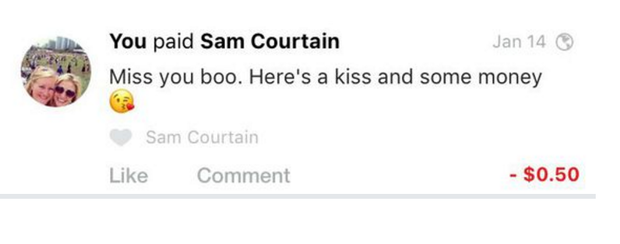Venmo: A secret, hip social network where you'd never expect it
When Sarah Mellema wanted to shoot a quick, encouraging message to her friend Sam, she didn’t open Facebook, Instagram, Twitter, Snapchat or WhatsApp. She didn’t email, text or call.
She used Venmo.
“Miss you boo. Here’s a kiss and some money ,” the 26-year-old Chicagoan wrote, attaching a digital payment of 50 cents to the message.
That one note may not seem significant, but it represents Venmo’s unlikely status as a thriving, millennial-heavy, emoji-infused social phenomenon, even though its reason for existing involves the boring business of paying bills and IOUs.
The U.S.-only mobile app, which is free to download and mostly free to use, pairs with people’s bank accounts to let them pay each other or request money, similar to Square Cash and Chase QuickPay. The difference is that Venmo lets its users make those payments and their associated messages public on social feeds that others can comment on and like.
Why would someone want to tell the world he just gave his roommate the rent money or paid back a friend for ? Perhaps a better question: why not?
Interviews with more than a dozen Venmo users showed how they are are finding new ways to jury-rig the app into a more social experience, such as using the messages for crude and silly inside jokes (“sex swing for new apt”; “money I stole from your wallet”), cataloging memorable events, sending money for drinks to a missed bachelorette party, or -- like with Mellema -- making micropayments to friends as a clever way of saying hi.
“Venmo is not an inherently social app in the way of Facebook or Twitter, but it offers emotional support and the ability to keep in touch,” said Cliff Lampe, a social-media professor at University of Michigan’s School of Information. “Young people are good at repurposing feeds and emojis and signals to mean different things and to become social even when it’s not intended to be social.”
Venmo has even been used to troll White House press secretary Sean Spicer. When someone uncovered an account with his name and picture, people inundated it with requests for money.
Venmo and owner PayPal say they’re keenly aware of their responsibility to preserve Venmo’s sometimes crass, sometimes goofy culture, and are working on more ways to help users express themselves.
Eggplant emojis and oversharing
This mashup of payments and social worlds, which launched to the public five years ago this month, doubled its user base last year to nearly 9 million, ahead of all but four U.S. retail banking apps, according to App Annie. PayPal said Venmo doubled its total transactions to $17.6 billion during the same time. And, a whopping 81 percent of Venmo’s users are millennials -- 10 percentage points higher than millennial darling Snapchat, ComScore reported last year.
A mix of its young users shunning credit cards, oversharing social culture and fewer moms and dads infiltrating the service have bolstered Venmo, which Braintree acquired in 2012 for $26.2 million. (PayPal bought Braintree a year later.)
The social feeds sparked new behaviors among users and revealed just how interactive payments can become. A typical usage involves one person paying for a large dinner party with her credit card, then Venmo’ing requests to everyone else for their shares. Alma Cook, a 25-year-old singer-songwriter in Los Angeles, said she’s put her Venmo account name on show posters to create a virtual tip jar for the audience.
Since most people already know why the money is being transferred, they instead crack jokes in the messages, including plenty of use of the eggplant emoji (code for penis). There are also a lot of drug references -- although it’s doubtful all of them are jokes.
Venmo has allowed for some new, and sometimes uncomfortable, forms of interaction. Brent Schneiders, a 28-year-old actor from North Hollywood, California, said he’s charged back women for dinner or drinks if dates go poorly.
“It’s more of me throwing a fit and trying to communicate to them that ‘I never want to see you again,’ “ he said.
He also noticed his ex-girlfriend paid his friend over Venmo and used the beer mug emoji . “I had no idea they even knew each other!” Schneiders said, adding that he stopped talking to both of them.
A friend bailed on hanging out with Raman Deol, saying she was sick, but then Deol noticed later that night the friend Venmo’ing someone else “thanks for the drinks” with wine glass emojis thrown in for good measure.
Deol wasn’t mad at her friend. She was mad at Venmo.
“The social feed of it, I don’t understand what it gets Venmo and what it gets users,” Deol, 27, of San Francisco, said. “And I think it’s extreme oversharing and toxic for our culture.”
All these points of tension are part of the growing pains of a new social network, Lampe said.
“A lot of concern about how these financial exchanges change social relationships,” he said, “are just frictions of norms not catching up to the changes of technologies.”
Origins of Venmo
Venmo becoming a social network comes as a surprise to Iqram Magdon-Ismail, the service’s boisterous, curly-haired 33-year-old co-founder. (He left Venmo in 2014 and is now working on an audio platform called Ense.)
He and Andrew Kortina, who met as freshman-year roommates at the University of Pennsylvania, came up with the idea after Magdon-Ismail forgot his wallet when visiting Kortina in New York in 2009 and had to rely on his friend to pay for everything upfront. It spurred him to ask: Why can’t I just text Andrew back the money?
The first version of Venmo (it stands for “Vendor Mobile,” Magdon-Ismail said) was private, text-based and only for BlackBerry phones. But, as more of their friends tested it out, Magdon-Ismail would wake up every morning and see all the latest payments.
“For me, it was like reading the newspaper,” Magdon-Ismail said. “I was thinking in the back of my head, ‘What if we made a feed for everybody. This kind of is like Facebook or Twitter for me.’ “
The decision to expose the payments publicly was controversial. Some at the company worried about privacy issues, others argued that the feed would be boring. Magdon-Ismail pushed for the change, and it helped the app go viral.
New users seeing their friends paying with the startup service created a layer of trust, known as “social proof,” Lampe said, and encouraged them to bring more friends along.
But, in addition to that trust, there are still clearly wrong ways to Venmo. After all, it exists in the highly regulated banking industry.
Ross Lipschultz, 26, from Chicago, said his account was suspended for days after he paid a friend back for drinks and wrote the message, as some forgotten joke: “A cool night in Havana.” Venmo emailed him that the reference to Cuba’s capital was flagged for potentially violating US sanctions under the federal Office of Foreign Assets Control.
It can be so easy to send and receive money that Sarah Vakili accidentally messed up the process. At the bar American Whiskey in Manhattan watching a University of Georgia football game, her boyfriend offered to cover the tab upfront for a large group of friends.
Vakili grabbed his phone and sent out Venmo messages to over 20 people for $60 each. But, she accidentally sent them money instead of requesting it, charging her boyfriend (temporarily) about $1,200 through the app.
“Just like when they say don’t drunk Facebook, don’t drunk Venmo,” she warned.
Social calculator apps
This year, Venmo plans to partner with more retailers, so people can use it more often and Venmo can make money off the business transactions. That could endanger the social feeds by clogging them with boring, personal or embarrassing purchases, such as paying for an oil change or hemorrhoid cream.
Mindful of the app’s culture, Ben Mills, Venmo’s head of product, said the service will give people more control on what they share when buying from retailers.
“We want to enhance that social experience,” Mills said. “Our users are teaching us payments are rarely about sending money.”
Venmo’s rise might spur the creation of other mundane apps with social functions -- like, say, a social calculator app -- to make them more engrossing. Or, maybe Venmo is just another youth-focused “it” social app destined to flame out.
Not all social app concepts will work. Amazon lets people share their purchases on social networks, but it’s not a widely used feature.
“If the designers of new systems understand the power of social feeds, I think that’s for sure a common design element you’re going to see,” Lampe said. “Any time humans interact with one another we’re constantly interested in what other humans are doing.”
In the meantime, be sure to Venmo your friends 50 cents and an emoji or two to let them know you’re thinking about them.
CNET Magazine: Check out a sample of the stories in CNET’s newsstand edition.
Technically Literate: Original works of short fiction with unique perspectives on tech, exclusively on CNET.
This article originally appeared on CNET as Venmo: The secret, hip social network you never heard of





